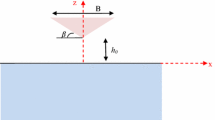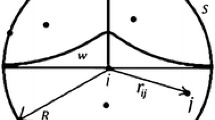Abstract
The hydrodynamic problems of water entry of a wedge are investigated by a modified ghost-cell immersed boundary method. The modifications correspond to a newly proposed scheme for dealing with fluid–body interaction, and incorporation of CIP (Constraint Interpolation Profile) method and THINC/SW (Tangent of Hyperbola for Interface Capturing with Slope Weighting) method. The modified ghost-cell immersed boundary method uses a compact interpolation structure and gives the fluid properties to the ghost cell to achieve a more accurate treatment of fluid–body interaction. It can preserve the sharpness of the immersed boundary. To validate the new method, simulations of water entry of symmetric and asymmetric wedges in a single degree of freedom and water entry of an asymmetric wedge in three degrees of freedom are carried out, respectively. The variations of pressure, vertical velocity, vertical acceleration, angular displacement, and angular acceleration against time are focused on. The evolution of the free surface and velocity distributions of fluid is also analyzed. The results of numerical simulations are compared with available experimental results and fairly good agreement is obtained, which indicates that the present model is reliable.























Similar content being viewed by others
References
Faltinsen OM (2000) Hydroelastic slamming. J Mar Sci Technol 5:49–65. https://doi.org/10.1007/s007730070011
Seddon C, Moatamedi M (2006) Review of water entry with applications to aerospace structures. Int J Impact Eng 32:1045–1067. https://doi.org/10.1016/j.ijimpeng.2004.09.002
Jiang Y, Bai T, Gao Y, Guan L (2018) Water entry of a constraint posture body under different entry angles and ventilation rates. Ocean Eng 153:53–59. https://doi.org/10.1016/j.oceaneng.2018.01.091
Wei Z, Hu C (2015) Experimental study on water entry of circular cylinders with inclined angles. J Mar Sci Technol 20:722–738. https://doi.org/10.1007/s00773-015-0326-1
Zou L, Wang A, Wang Z, Pei Y, Liu X (2019) Experimental study of freak waves due to three-dimensional island terrain in random wave. Acta Oceanol Sin 38:1–8. https://doi.org/10.1007/s13131-019-1390-x
Hu Z, Zhao X, Li M, Fang Z, Sun Z (2018) A numerical study of water entry of asymmetric wedges using a cip-based model. Ocean Eng 148:1–16. https://doi.org/10.1016/j.oceaneng.2017.11.011
Yang L, Yang H, Yan S, Ma Q, Bihnam M et al (2016) Comparative study on water impact problem. In: The 26th international ocean and polar engineering conference, international society of offshore and polar engineers
Peskin CS (2002) The immersed boundary method. Acta Num 11:479–C517. https://doi.org/10.1017/S0962492902000077
Von Kármán T (1929) The impact of seaplane floats during landing. Nat Adv Com Aeronautics Tech Note 321:309–313
Wagner H (1932) Über stoß-und gleitvorgänge an der oberfläche von flüssigkeiten. ZAMM J Appl Math Mech 12:193–215. https://doi.org/10.1002/zamm.19320120402
Yu P, Li H, Ong MC (2019) Hydroelastic analysis on water entry of a constant-velocity wedge with stiffened panels. Mar Struct 63:215–238. https://doi.org/10.1016/j.marstruc.2018.09.007
Sun P, Zhang A, Marrone S, Ming F (2018) An accurate and efficient sph modeling of the water entry of circular cylinders. Appl Ocean Res 72:60–75. https://doi.org/10.1016/j.apor.2018.01.004
Yettou EM, Desrochers A, Champoux Y (2006) Experimental study on the water impact of a symmetrical wedge. Fluid Dyn Res 38:47–66. https://doi.org/10.1016/j.fluiddyn.2005.09.003
Tveitnes T, Fairlie-Clarke A, Varyani K (2008) An experimental investigation into the constant velocity water entry of wedge-shaped sections. Ocean Eng 35:1463–1478. https://doi.org/10.1016/j.oceaneng.2008.06.012
De Backer G, Vantorre M, Beels C, De Pré J, Victor S, De Rouck J, Blommaert C, Van Paepegem W (2009) Experimental investigation of water impact on axisymmetric bodies. Appl Ocean Res 31:143–156. https://doi.org/10.1016/j.apor.2009.07.003
Jalalisendi M, Osma SJ, Porfiri M (2015) Three-dimensional water entry of a solid body: a particle image velocimetry study. J Fluids Struct 59:85–102
Russo S, Jalalisendi M, Falcucci G, Porfiri M (2018) Experimental characterization of oblique and asymmetric water entry. Exp Thermal Fluid Sci 92:141–161. https://doi.org/10.1016/j.expthermflusci.2017.10.028
Zhao R, Faltinsen O (1993) Water entry of two-dimensional bodies. J Fluid Mech 246:593–612. https://doi.org/10.1017/S002211209300028X
Wu G, Sun H, He Y (2004) Numerical simulation and experimental study of water entry of a wedge in free fall motion. J Fluids Struct 19:277–289. https://doi.org/10.1016/j.jfluidstructs.2004.01.001
Gong K, Liu H, Wang Bl (2009) Water entry of a wedge based on sph model with an improved boundary treatment. J Hydrodyn 21:750–757. https://doi.org/10.1016/S1001-6058(08)60209-7
Shao S (2009) Incompressible sph simulation of water entry of a free-falling object. Int J Num Methods Fluids 59:91–115. https://doi.org/10.1002/fld.1813
Shao J, Yang Y, Gong H, Liu M (2019) Numerical simulation of water entry with improved sph method. Int J Comput Methods 16:1846004. https://doi.org/10.1142/S0219876218460040
Zhu L, Peskin CS (2003) Interaction of two flapping filaments in a flowing soap film. Phys Fluids 15:1954–1960. https://doi.org/10.1063/1.1582476
Su SW, Lai MC, Lin CA (2007) An immersed boundary technique for simulating complex flows with rigid boundary. Comput Fluids 36:313–324. https://doi.org/10.1016/j.compfluid.2005.09.004
Balaras E (2004) Modeling complex boundaries using an external force field on fixed cartesian grids in large-eddy simulations. Comput Fluids 33:375–404. https://doi.org/10.1016/S0045-7930(03)00058-6
Zhang N, Zheng ZC (2007) An improved direct-forcing immersed-boundary method for finite difference applications. J Comput Phys 221:250–268. https://doi.org/10.1016/j.jcp.2006.06.012
Mohd-Yusof J (1997) For simulations of flow in complex geometries. Annual Research Briefs 317
Bandringa H (2010) Immersed boundary methods. Master thesis, University of Groningen 9700
Yang J, Stern F (2009) Sharp interface immersed-boundary/level-set method for wave-body interactions. J Comput Phys 228:6590–6616. https://doi.org/10.1016/j.jcp.2009.05.047
Calderer A, Kang S, Sotiropoulos F (2014) Level set immersed boundary method for coupled simulation of air/water interaction with complex floating structures. J Comput Phys 277:201–227. https://doi.org/10.1016/j.jcp.2014.08.010
Bihs H, Kamath A (2017) A combined level set/ghost cell immersed boundary representation for floating body simulations. Int J Num Methods Fluids 83:905–916. https://doi.org/10.1002/fld.4333
Zhao X, Ye Z, Fu Y, Cao F (2014) A cip-based numerical simulation of freak wave impact on a floating body. Ocean Eng 87:50–63. https://doi.org/10.1016/j.oceaneng.2014.05.009
Yabe T, Xiao F, Utsumi T (2001) The constrained interpolation profile method for multiphase analysis. Journal of Computational physics 169:556–593. https://doi.org/10.1006/jcph.2000.6625
Xiao F, Ii S, Chen C (2011) Revisit to the thinc scheme: a simple algebraic vof algorithm. J Comput Phys 230:7086–7092. https://doi.org/10.1016/j.jcp.2011.06.012
Mittal R, Dong H, Bozkurttas M, Najjar F, Vargas A, Von Loebbecke A (2008) A versatile sharp interface immersed boundary method for incompressible flows with complex boundaries. J Comput Phys 227:4825–4852. https://doi.org/10.1016/j.jcp.2008.01.028
Hu C, Kashiwagi M (2009) Two-dimensional numerical simulation and experiment on strongly nonlinear wave-body interactions. J Mar Sci Technol 14:200–213. https://doi.org/10.1007/s00773-008-0031-4
Pan D, Shen TT (2009) Computation of incompressible flows with immersed bodies by a simple ghost cell method. Int J Num Methods Fluids 60:1378–1401. https://doi.org/10.1002/fld.1942
Tseng YH, Ferziger JH (2003) A ghost-cell immersed boundary method for flow in complex geometry. J Comput Phys 192:593–623. https://doi.org/10.1016/j.jcp.2003.07.024
Franke R (1982) Scattered data interpolation: tests of some methods. Math Comput 38:181–200. https://doi.org/10.1090/S0025-5718-1982-0637296-4
Ross JM (2009) Human factors for naval marine vehicle design and operation. Ashgate Publishing, Ltd
Ahmadzadeh M, Saranjam B, Fard AH, Binesh A (2014) Numerical simulation of sphere water entry problem using eulerian-lagrangian method. Appl Math Model 38:1673–1684. https://doi.org/10.1016/j.apm.2013.09.005
Lewis SG, Hudson DA, Turnock SR, Taunton DJ (2010) Impact of a free-falling wedge with water: synchronized visualization, pressure and acceleration measurements. Fluid Dyna Res 42:035509
Tenzer M, Moctar Oe, Schellin TE (2015) Experimental investigation of impact loads during water entry. Ship Technol Res 62:47–59. https://doi.org/10.1179/0937725515Z.0000000003
Panciroli R (2013) Water entry of flexible wedges: some issues on the fsi phenomena. Appl Ocean Res 39:72–74
Sun H, Sun Z, Liang S, Zhao X (2019) Numerical study of air compressibility effects in breaking wave impacts using a cip-based model. Ocean Eng 174:159–168. https://doi.org/10.1016/j.oceaneng.2019.01.050
Barjasteh M, Zeraatgar H, Javaherian MJ (2016) An experimental study on water entry of asymmetric wedges. Appl Ocean Res 58:292–304. https://doi.org/10.1016/j.apor.2016.04.013
Yu P, Li H, Ong MC (2018) Numerical study on the water entry of curved wedges. Ships Offshore Struct 13:885–898. https://doi.org/10.1080/17445302.2018.1471776
Camilleri J, Taunton D, Temarel P (2018) Full-scale measurements of slamming loads and responses on high-speed planing craft in waves. J Fluids Struct 81:201–229. https://doi.org/10.1016/j.jfluidstructs.2018.05.006
Oger G, Doring M, Alessandrini B, Ferrant P (2006) Two-dimensional sph simulations of wedge water entries. J Comput Phys 213:803–822. https://doi.org/10.1016/j.jcp.2005.09.004
Lee J, Kim J, Choi H, Yang KS (2011) Sources of spurious force oscillations from an immersed boundary method for moving-body problems. J Comput Phys 230:2677–2695. https://doi.org/10.1016/j.jcp.2011.01.004
Masoomi M, Yousefifard M, Ramiar A (2017) Numerical investigation of symmetry and asymmetry rigid wedge slamming using openfoam code. Mod Mech Eng 17:343–352
Wen P, Qiu W, et al., (2016) Numerical prediction of forces and pressures onwedge and ship sections based on a cip method. In: The 26th International Ocean and Polar Engineering Conference, International Society of Offshore and Polar Engineers
Xu L, Troesch A, Peterson R (1999) Asymmetric hydrodynamic impact and dynamic response of vessels. J Offshore Mech Arctic Eng 121:83–89
Acknowledgements
This study was partially supported by the National Natural Science Foundation of China (Grant No. 51679212), Zhejiang Provincial Natural Science Foundation of China (Grant No. LR16E090002), the Fundamental Research Funds for the Central Universities (Grant No. 2018QNA4041).
Author information
Authors and Affiliations
Corresponding author
Additional information
Publisher’s Note
Springer Nature remains neutral with regard to jurisdictional claims in published maps and institutional affiliations.
About this article
Cite this article
Zheng, K., Zhao, X., Yang, Z. et al. Numerical simulation of water entry of a wedge using a modified ghost-cell immersed boundary method. J Mar Sci Technol 25, 589–608 (2020). https://doi.org/10.1007/s00773-019-00666-9
Received:
Accepted:
Published:
Issue Date:
DOI: https://doi.org/10.1007/s00773-019-00666-9
Keywords
- CIP method
- Immersed boundary method
- VOF method
- Symmetric and asymmetric water impact
- Slamming
- Hydrodynamic behavior




